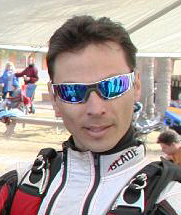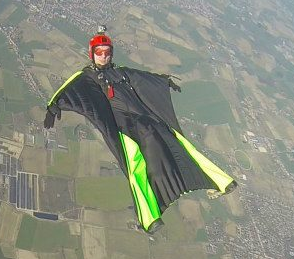Recommended Posts
The111 0
QuoteWith the high performance of the newer designs even the tandems are below your deployment altitude before you can get near them, unless you dive down to them.
He's tracking... I thought he meant wingsuits at first too. The tandem masters (or anybody) are certainly not going to want somebody exiting behind them and tracking in circles.
mrken 0
Thanks guys.
badenhop 0
I've got all I need, Jesus and gravity. Dolly Parton
http://www.AveryBadenhop.com
The first attachment shows how an entire plane load of trackers could conduct a tracking dive. This means no other skydivers, everyone on the plane is on the same tracking dive.
The second attachment shows how a small group of trackers could conduct a tracking dive after other skydivers have gotten out of the plane and have allowed enough horizontal seperation (time) betwen the the last skydiver and their group.
The process requires a bit more planning with the aircraft/DZ if your have aircraft in trail or on parallel jump runs but it is not impossible as it has been done safely at events such as WFFC and the Eloy holiday boogie in the past. This requires that the person organizing the dive fully understand when and how to impliment the right type of pattern to be flown based on the circumstances.
Some people dream about flying, I live my dream
SKYMONKEY PUBLISHING
OSOK 0
After more and more tracks, I hated stopping for the 180s... so I started tracking, and turning 180 while on a hard track. This helped me both with maneuvering and I didn't have to stop tracking for the 180.
Lately what I've been doing is just tracking as per the second pic on the above post. I'm very aware for where I am, and if needed, I'll open up a bit higher than planned if I have to just so I can make it back.
Sometimes they do jump run offset a bit from the wind direction. So, if the wind is coming from the E, and they do jumprun NE, then I'll track N so when I open I have the wind on my back to help me get back.
What has helped me a lot is paying close attention to the jumprun direction and just do what makes sense.
Thijs 0
QuoteI was always told to track perpendicular to jumprun, turn 180, the track back... and do this until pulltime. It makes a lot of sense to me because you're staying on your portion of space, jump run wise.
No, you are not staying in your portion of space. It is very easy to be way of your space when you track away from jumprun and then back to it.
I do a lot of tracking myself. If I can, I exit last (if there are no tandems or AFF on the load) an fly a U-shaped pattern (upjumprun, cross, and downwind). Other wise I fly and L-shaped pattern (cross and downwind or upwind), but I never track back towards jumprun.
dragon2 0
ciel bleu,
Saskia
MarkM 0
QuoteI track a lot by myself on loads that have belly flyers, freeflyers, and tandems. I was always told to track perpendicular to jumprun, turn 180, the track back... and do this until pulltime. It makes a lot of sense to me because you're staying on your portion of space, jump run wise.
It'd be really easy to drift into other people's airspace on the track back. Scott's 45 degree track I think would be ideal, but as a lowbie you may be pretty much stuck doing what others at your DZ tell you to do. You can't exactly go "Yeah, but this guy on the internet said I should do it this one way..."
When I was doing perpendicular and 180's back when I had 80 jumps I tried to make it a point to not come past half way back. That way I was at least still off the flight line. And since I was opening higher than most people and had a big canopy, I could make it back pretty easily.
Just be really aware of other people tracking on the plane.
mrken 0
Quote
The second attachment shows how a small group of trackers could conduct a tracking dive after other skydivers have gotten out of the plane and have allowed enough horizontal seperation (time) betwen the the last skydiver and their group.
Followed it today and made it back to the LZ with enough time to follow a predictable landing pattern no problem, thanks! jump 100 yay!
jakee 1,257
QuoteQuote
The second attachment shows how a small group of trackers could conduct a tracking dive after other skydivers have gotten out of the plane and have allowed enough horizontal seperation (time) betwen the the last skydiver and their group.
Followed it today and made it back to the LZ with enough time to follow a predictable landing pattern no problem, thanks! jump 100 yay!
Congrats!
The second hundred should go much easier than the first hundred - and then its wingsuit time!






In theory, I guess "staying in the same area" could work, but it would be very hard to ensure you were actually doing this. Basing it on eyesight would be impossible, and if even if you made sure to keep each leg of your zig-zag exactly the same amount of time, you wouldn't be able to guarantee you were covering the same amount of ground each time, and staying in your area.
The thing is, you can't be sure of your distance, but you can be sure of your altitude. If you exit at 13k, and track perpendicular until 9k, you've now tracked for 4k feet, and you are guaranteed to be further away from the line of flight that somebody who just tracks for 1000ft after their RW jump before pulling. Now if you KEEP flying in that same direction for a few thousand more feet (until pull time) as you said you were doing, you will end up very far away, as you figured out. But if you track now parallel to line of flight, you can actually open closer to the LZ than you were when you got out of the plane, and you are still a safe distance away from the line of flight, further than anybody else could be.
Good luck.
Share this post
Link to post
Share on other sites